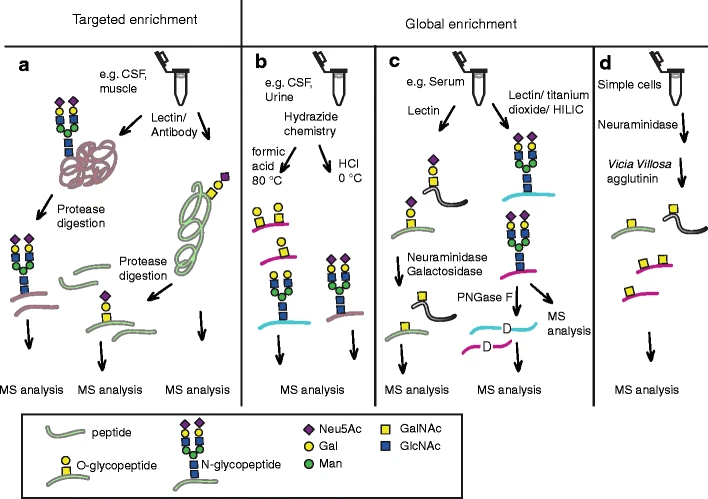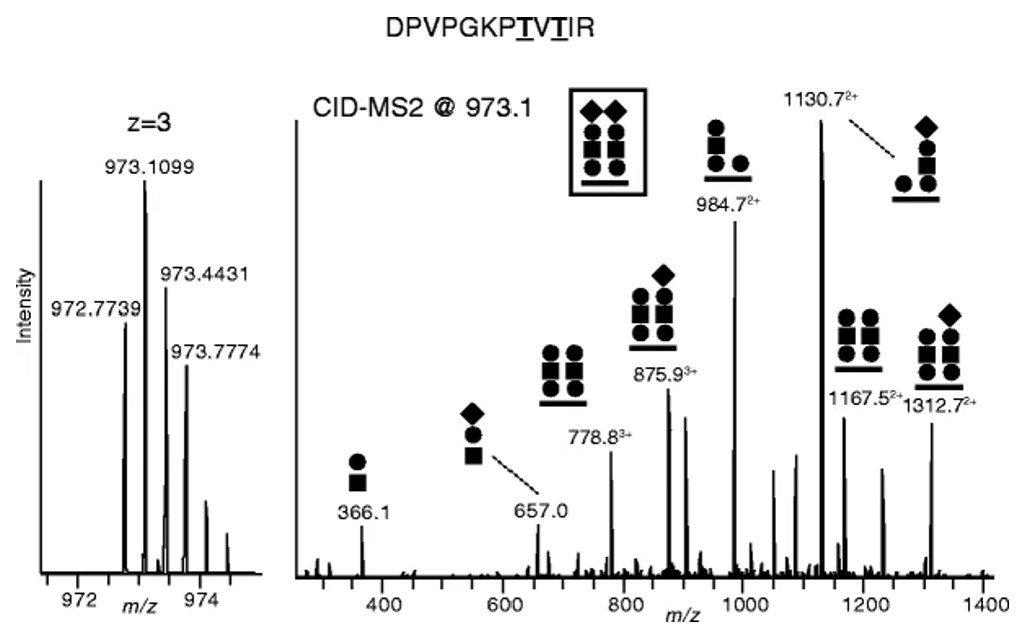Glycoprotein Structure Analysis Services
Glycoproteins are extremely important to a variety of biological processes, but glycoproteins analysis is a big challenge because of the low abundance and heterogeneity of glycans. As a forward-looking company as well as a leading customer service provider, Creative Biolabs has successfully developed versatile glycoprotein analysis platforms to provide the largest and most diverse portfolio of glycoprotein products or services. Glycoprotein structure analysis helps us win a good reputation among our worldwide customers in the glycoprotein engineering. We are glad to work with you in your glycoprotein project to help you get milestone success.
Background of Glycoprotein Structure Analysis
Glycosylation is a fundamental modification of proteins, which plays an important role in many physiological and pathological processes, including protein folding and trafficking, cell-cell and cell-matrix interaction, cellular differentiation, fertilization, immune response, the initiation and metastasis of tumors. Thus, the analysis of glycoproteins structure allows characterization of important biological molecules, including antibodies, vaccines, enzymes, etc. What's more, glycoprotein structure analysis would be of great diagnostic and clinical importance. Carbohydrate chains or glycans attached to the peptide backbone are extremely diverse and complex, moreover, one typical feature of glycosylation is the presence at a single site of any one of a number of glycan structures. All of these properties make it a great challenge for analytical structural studies of glycoproteins.
In addition to the extreme structural diversity and complexity of glycan structures, one feature of protein glycosylation is the presence at a single site of any one of a number of glycan structures. This property gives rise to an extremely heterogeneous population of glycoproteins, termed glycoforms. The complexity of the glycan structures, the multiple substitutions (microheterogeneity) at glycosylation sites, and the structural diversity associated with the protein backbone itself represent an enormous task for analytical structural studies.
What Can We Provide?
Aided by a series of glycoprotein analysis platforms, we can provide glycan profiling, glycomic profiling, glycosylation site mapping, and glycan sequencing service. Our advanced and diversified technologies can meet your specific needs precisely.
-
Glycosylation site mapping has several benefits for the glycoprotein study. It can not only provide an indication of the function of glycan but also can shed light on the protein’s glycosylation profile and microheterogeneity and hence, plausibly, its activity. Matrix-assisted laser desorption ionization time-of-flight mass spectrometry (MALDI-TOF MS) is the common method for the large scale of glycosylation sites mapping from glycoproteins expressed by plasma/serum, cell, tissue or organism.
-
Glycan sequencing is usually performed by the sequential enzymatic N-glycan and chemical O-glycan release from glycopeptides with intervening solid phase extraction and derivatization, which is a powerful technique in determining the sequence and structure of glycans.
 Fig.1 Schematic representation of methods for targeted and global enrichment of glycoproteins and glycopeptides.1
Fig.1 Schematic representation of methods for targeted and global enrichment of glycoproteins and glycopeptides.1
Features of our Technologies
-
Specificity and veracity
-
High sensitivity
-
Stability and consistency
-
Low-cost
-
Best after-sale service
Working with Us to Promote Your Success!
Glycoprotein structure analysis has become a regular study in glycosylation engineering, which is beneficial for the assignment of distinct functional properties to defined structural features. With decades of experience, Creative Biolabs has successfully completed a lot of therapeutic glycoprotein projects. We can offer a whole set of glycoprotein structure analysis service to help you get landmark development. We can also customize our offering to meet your specific project needs. If you are interested, please contact us without hesitation.
Published data
Glycoprotein structure analysis is essential for therapeutic glycoprotein research. There are several methods, such as MS, that are used to analyze the structure of glycoproteins. This article gives us a comprehensive overview of the methods used for structural analysis of glycoproteins. Among them, MS is widely used in glycoprotein structure analysis due to its higher analytical speed, sensitivity, and high-quality resolution. For example, for N-glycoproteins, MS-based methods can elucidate the glycoprotein identity, characterize the glycan structure, and determine its exact attachment site. The multiple methods for enriching and characterizing glycoproteins introduced in this study provide methodological support for optimizing our glycoprotein structure analysis process.
 Fig.2 MS-based analysis of tryptic glycopeptides.1
Fig.2 MS-based analysis of tryptic glycopeptides.1
FAQs
Q1: Why is structural analysis of glycoproteins important?
A1: Glycoproteins play an important role in many biological processes such as cell growth, differentiation, and intercellularity. Abnormalities in glycoprotein structure are associated with certain diseases. Glycoprotein structure analysis helps to decipher their functions in physiological activities, explore the interactions between glycoproteins and other molecules, understand the mechanism of disease, and screen for disease biomarkers.
Q2: Can glycoprotein structure analysis services be customized for specific research needs?
A2: Yes, of course, the analysis can be customized. Our glycoprotein structure analysis services include glycomic analysis, glycan analysis, glycan sequencing, and glycosylation site mapping. We always adhere to our client-focused philosophy and provide customizable glycoprotein structure analysis solutions to meet the unique requirements of research projects.
Customer Review
Superior Glycoprotein Structure Analysis Technology
"Creative Biolabs helped us to comprehensively analyze the structure of glycoproteins in our samples. Throughout the process, they demonstrated exceptional professionalism and a high level of skill. Not only did they provide detailed analysis results, but also meaningful explanations of the data. Their attention to detail was commendable."
Valuable Glycoprotein Structure Analysis Insights
"We were impressed with the quality of Creative Biolabs' glycoprotein structure analysis services and their commitment to client satisfaction. Throughout the process, they kept us updated on the progress of the glycoprotein structure analysis and also provided some valuable insights to help us further analyze the results. We were very satisfied with their glycoprotein structure analysis services."
Reference
-
Nilsson, Jonas, et al. "Targeting the glycoproteome." Glycoconjugate journal 30 (2013): 119-136. Distributed under Open Access license CC BY 2.0, without modification.
For Research Use Only.
Related Services

 Fig.1 Schematic representation of methods for targeted and global enrichment of glycoproteins and glycopeptides.1
Fig.1 Schematic representation of methods for targeted and global enrichment of glycoproteins and glycopeptides.1
 Fig.2 MS-based analysis of tryptic glycopeptides.1
Fig.2 MS-based analysis of tryptic glycopeptides.1



